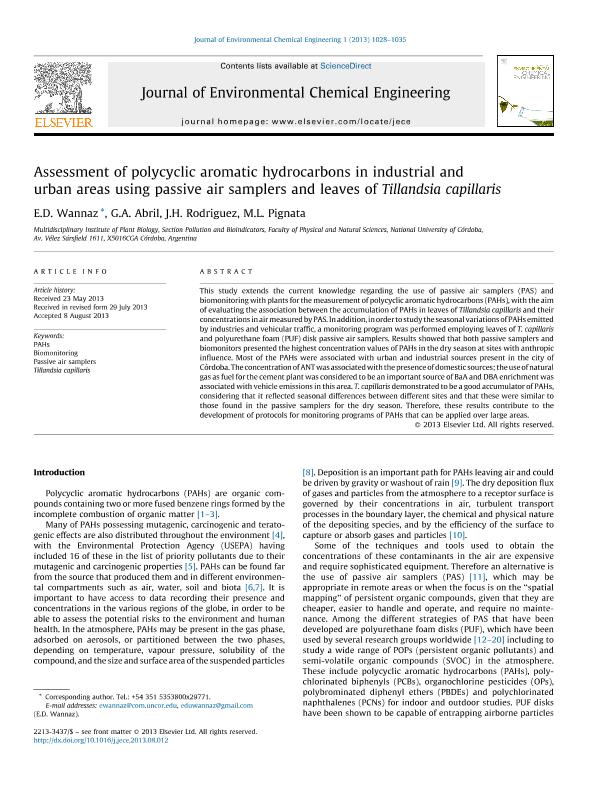Mostrar el registro sencillo del ítem
dc.contributor.author
Wannaz, Eduardo Daniel

dc.contributor.author
Abril, Gabriela Alejandra

dc.contributor.author
Rodriguez, Judith Hebelen

dc.contributor.author
Pignata, Maria Luisa

dc.date.available
2016-12-28T18:14:17Z
dc.date.issued
2013-08
dc.identifier.citation
Wannaz, Eduardo Daniel; Abril, Gabriela Alejandra; Rodriguez, Judith Hebelen; Pignata, Maria Luisa; Assessment of polycyclic aromatic hydrocarbons in industrial and urban areas using passive air samplers and leaves of Tillandsia capillaris; Elsevier Science; Journal of Environmental Chemical Engineering; 1; 4; 8-2013; 1028-1035
dc.identifier.issn
2213-3437
dc.identifier.uri
http://hdl.handle.net/11336/10517
dc.description.abstract
This study extends the current knowledge regarding the use of passive air samplers(PAS)and biomonitoring with plants for the measurement of polycyclic aromatic hydrocarbons(PAHs), with the aim of evaluating the association between the accumulation of PAHs in leaves of Tillandsia capillaris and their concentrations in air measured by PAS. In addition, in order to study the seasonal variations of PAHs emitted by industries and vehicular traffic, a monitoring program was performed employing leaves of T. capillaris and polyurethane foam(PUF)disk passive air samplers. Results showed that both passive samplers and biomonitors presented the highest concentration values of PAHs in the dry season at sites with anthropic influence. Most of the PAHs were associated with urban and industrial sources present in the city of Córdoba. The concentration of ANT was associated with the presence of domestic sources; the use of natural gas as fuel for the cement plant was considered to be an important source of BaA and DBA enrichment was associated with vehicle emissions in this area. T. capillaris demonstrated to be a good accumulator of PAHs, considering that it reflected seasonal differences between different sites and that these were similar to those found in the passive samplers for the dry season. Therefore, these results contribute to the development of protocols for monitoring programs of PAHs that can be applied over large areas.
dc.format
application/pdf
dc.language.iso
eng
dc.publisher
Elsevier Science

dc.rights
info:eu-repo/semantics/openAccess
dc.rights.uri
https://creativecommons.org/licenses/by-nc-nd/2.5/ar/
dc.subject
Pahs
dc.subject
Biomonitoring
dc.subject
Passive Air Samplers
dc.subject
Tillandsia Capillaris
dc.subject.classification
Otras Ciencias de la Tierra y relacionadas con el Medio Ambiente

dc.subject.classification
Ciencias de la Tierra y relacionadas con el Medio Ambiente

dc.subject.classification
CIENCIAS NATURALES Y EXACTAS

dc.title
Assessment of polycyclic aromatic hydrocarbons in industrial and urban areas using passive air samplers and leaves of Tillandsia capillaris
dc.type
info:eu-repo/semantics/article
dc.type
info:ar-repo/semantics/artículo
dc.type
info:eu-repo/semantics/publishedVersion
dc.date.updated
2016-12-12T14:16:30Z
dc.journal.volume
1
dc.journal.number
4
dc.journal.pagination
1028-1035
dc.journal.pais
Países Bajos

dc.journal.ciudad
Amsterdam
dc.description.fil
Fil: Wannaz, Eduardo Daniel. Consejo Nacional de Investigaciones Científicas y Técnicas. Centro Científico Tecnológico Córdoba. Instituto Multidisciplinario de Biología Vegetal (p); Argentina
dc.description.fil
Fil: Abril, Gabriela Alejandra. Consejo Nacional de Investigaciones Científicas y Técnicas. Centro Científico Tecnológico Córdoba. Instituto Multidisciplinario de Biología Vegetal (p); Argentina
dc.description.fil
Fil: Rodriguez, Judith Hebelen. Consejo Nacional de Investigaciones Científicas y Técnicas. Centro Científico Tecnológico Córdoba. Instituto Multidisciplinario de Biología Vegetal (p); Argentina
dc.description.fil
Fil: Pignata, Maria Luisa. Consejo Nacional de Investigaciones Científicas y Técnicas. Centro Científico Tecnológico Córdoba. Instituto Multidisciplinario de Biología Vegetal (p); Argentina
dc.journal.title
Journal of Environmental Chemical Engineering
dc.relation.alternativeid
info:eu-repo/semantics/altIdentifier/doi/http://dx.doi.org/10.1016/j.jece.2013.08.012
dc.relation.alternativeid
info:eu-repo/semantics/altIdentifier/url/http://www.sciencedirect.com/science/article/pii/S2213343713001383
Archivos asociados
